5+ Sample Software Developer Contract
-
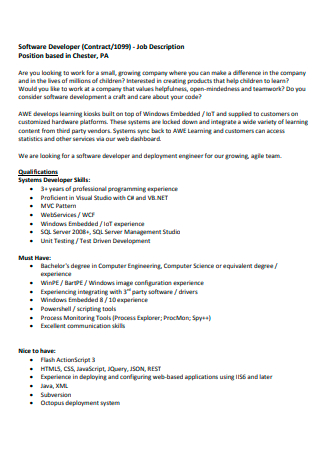
Software Developer Contract Template
download now -
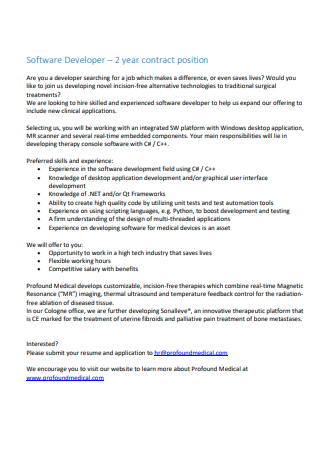
Software Developer 2 year Contract
download now -
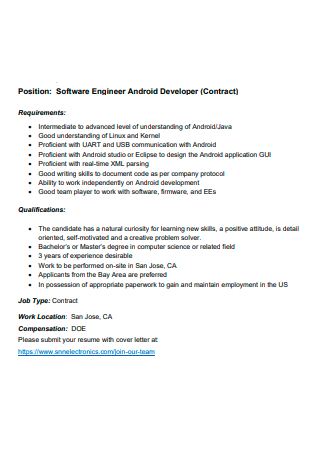
Software Engineer Android Developer Contract
download now -

Software Developer Contract Notification
download now -
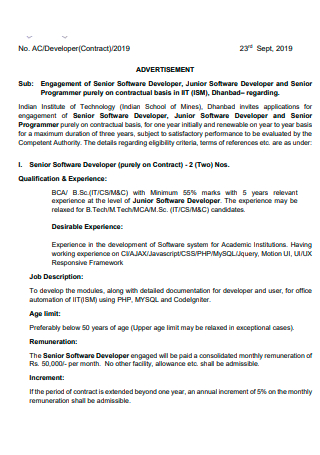
Software Developer Contract Advertisement
download now -
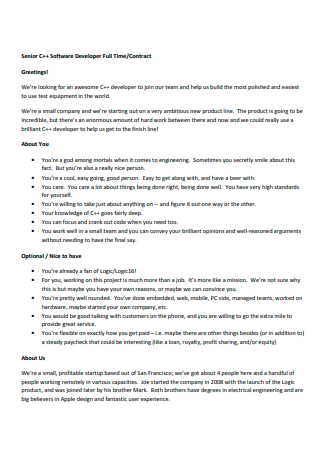
Senior C++ Software Developer Contract
download now
FREE Software Developer Contract s to Download
5+ Sample Software Developer Contract
What Is a Software Developer Contract?
Types of Software Developer Contracts
Key Points of a Software Developer Contract
How to Write a Software Developer Contract
FAQs
What is the distinction between an agreement and a contract?
How much do software developers charge?
What is software maintenance?
What Is a Software Developer Contract?
A software developer contract is an arrangement between a corporation and a software developer in which the company expresses its ideas and needs. The program is then designed according to the company’s timetable limitations by the developer. Such Software Development contract is common in software organizations where developers are contracted to create computer software or mobile application for both commercial and personal use. As a result, defining the scope of rights of both developers and enterprises about software becomes critical. If you need additional references, you can check out the software developer contract sample provided in this article.
Types of Software Developer Contracts
Just like any other contract, there are varieties of them for different purposes and intentions. It is important for you to be aware of the type of software developer contract you will be presenting to your client because it matters in the long-term discussion regarding the contents and updates that you both will be referring to through your engagement. This list has been curated for you for additional information that you can make use of as you prepare the suitable contract before your Client. Go over the many sorts of contracts you can use before we get into the specifics of software developer contracts.
Key Points of a Software Developer Contract
Now that you have gone through the various contract types and their respective descriptions, you should have a good understanding of which one best matches you and your vendor. It is time to proceed to the next list prepared for you. Proceed to the contract and examine what software development-specific elements you should include. It is important to be aware of what to include in the document because the clients will want to be informed of the ties you will be making with them.
How to Write a Software Developer Contract
The structure of a software developer contract resembles that of any other Service Contract. Termination conditions, dispute resolution, controlling law, and other common parts should all be included. When it comes to software development, though, there are a few things you should agree on with your client. A software developer contract template is provided below, which you may find useful in drafting the software developer contract. As a software developer contractor, you have to ensure that there is no important content left behind otherwise the client would be confused about the details included.
-
1. Developer’s Duties
Starting out the contract is information related to you, as the developer. All of the developer’s responsibilities, including the development of software in accordance with the company’s software requirements specifications and following the company’s milestones at various stages, answering questions about the software for a specified time even after delivery, and acknowledging the company’s right to terminate the contract for breach of the contract’s terms, shall be specified in the contract.
-
2. Scope of Work
The Scope of Work might help the software developer understand what is expected of them. This implies it’s critical to define exactly what will be included in the task and what will be excluded. It’s best to specify the number of hours you will be working on the project, the approach you will use, any additional maintenance services, and any necessary adjustments. These types of questions about the scope of work should be addressed in the parties’ agreement. On or before the delivery date, the program must function in line with the specifications. The developer promises to make reasonable efforts to correct any non-conformity upon receiving such notice.
-
3. Training and Support Maintenance
The developer’s responsibilities for educating corporate personnel in the use of the program, as well as the approximate hours of training and the location of training, must be specified. Any additional expenditures associated with training must also be disclosed. The duration of the developer’s support and maintenance for the program, as well as the terms of renewal, must be specified. Training and support maintenance is written out directly. It is purposely meant to respond to the needs of the clients. The Plan will detail measures for overcoming any hurdles to learning and employment that have been identified.
-
4. Confidential Information
Confidential information is frequently placed under the control of either party during software development. It’s critical that the contract spells out how confidential data will be treated. Many software developer contracts also spell out the ramifications of failing to keep secret information private. Intellectual property, payment accounts, fee schedules, source code, patent information, and copyrighted material are all examples of confidential information. You should prepare a Confidential Information Agreement that could be presented separately or with the contract so your client can thoroughly read through it.
-
5. Limitation of Liability
Neither party will be liable to the other for any indirect, incidental, consequential, special, punitive, or exemplary damages arising out of or related to the performance of the work, regardless of the type of claim or whether that party has been advised of the possibility of such damages, including, but not limited to, lost profits, revenue or anticipated profits, or lost business, regardless of the type of claim or whether that party has been advised of the possibility of such damages.
-
6. Payment Terms
Any software developer contract should precisely outline payment terms, including amounts, milestones, and dates. Determine whether expenses will be repaid and what will happen if a Payment is not made on time. You should also specify whether the payment will be made in installments or directly. Failure to pay may result in the contract being terminated. It could potentially lead to legal action. Make sure that the software developer contract rates are specified so the client is aware of their budget. The software developer contract may include an agreement between the parties that the breaching party is responsible for the attorneys’ fees.
FAQs
What is the distinction between an agreement and a contract?
An agreement is a promise or arrangement made between two or more persons for the purpose of achieving a common goal. A contract is a legally enforceable agreement that generates a shared obligation between two or more people. The primary distinction between a contract and an agreement is that a contract is legally enforceable. The only necessity for an agreement is that all parties understand their rights and responsibilities. A contract has precise terms and rules that can be enforced by law, whereas the only necessary for an agreement is that all parties understand their rights. Know this before you make a Software Development Agreement.
How much do software developers charge?
The most effective method is to assess a project based on its worth. This method is the most advanced and has the biggest potential earnings. You tie your rate to how much quality you can deliver, rather than the market rate, expertise, experience, or your desired earnings. The rough range of software development costs, based on our experience, is $50,000 to $250,000. The lower cost is appropriate for a small program that took less than 750 hours to create. The cost of developing a multi-platform program with an application server is likely to be in the six figures.
What is software maintenance?
The process of upgrading, improving, and fixing bugs to stay up with client needs is known as software maintenance. After a product has been released, software maintenance is performed for a variety of purposes, including enhancing the software altogether, addressing faults or bugs, increasing performance, and more. The maintenance of software is just as vital as the development of it. You will have trouble-free use and strong result, fewer difficulties, and better adaptation to changes in the industry if you maintain software on a regular basis. It is important for software to undergo maintenance so that their performance is ensured to run smoothly otherwise, failure to maintain it could end up costing the client.
You have reached the end of the article and are more than ready to begin preparing a contract between software developer and client. You may encounter and deal with difficult clients which could prompt you to rush the software development process. This is why the templates provided for you will help you to save time and impress your clients as well. Remember to define and clarify the software developer contractor salary you will be charging so you won’t be underpaid for your services. What are you waiting for? Start writing that software developer contract now!
